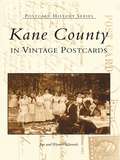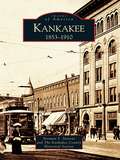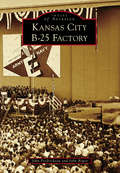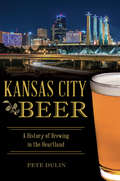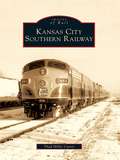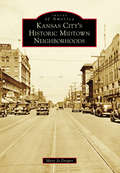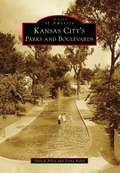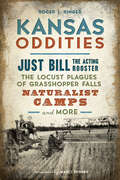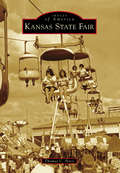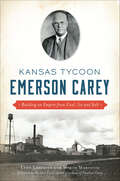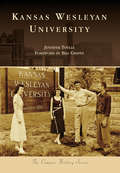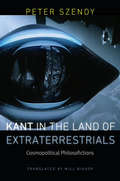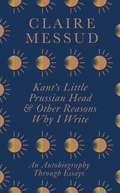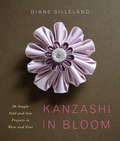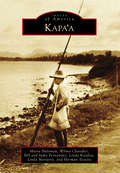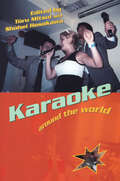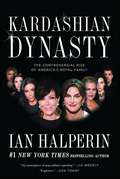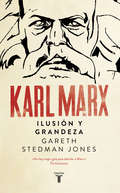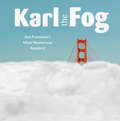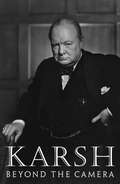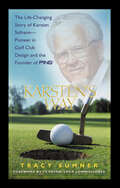- Table View
- List View
Kane County in Vintage Postcards (Postcard History)
by Jim Edwards Wynette EdwardsRich land at the edge of a great prairie with the wonderful Fox River flowing through it, providing a source of power-this is what the settlers of Kane County found when they arrived. Early pioneers came from the eastern United States in the 1830s, and later migrated from Europe. Kane County in Vintage Postcards tells the story of the beginning of Kane County through its first 100 years, 1838 through 1938, featuring images of that period.This new history of Kane County includes an essay on the importance of postcards as historical data, a general history of the county, and a section-by-section look at 27 cities and villages. More than 200 pictures and colorful narratives tell of the accomplishments by those first few generations who lived and died in the county.
Kankakee: 1853-1910
by The Kankakee County Historical Society Norman S. StevensKankakee became the county seat when Kankakee County was established in 1853. The largest city in the county, Kankakee embraced the railroad from its 19th-century beginning, becoming an important railroad hub in Illinois. The Kankakee County Historical Society has long worked to preserve the city's history and it celebrates its 100th anniversary in 2006, making it one of Illinois' oldest historical societies. The images in this book come from the society's large collection and they represent many slices of Kankakee life from 1853 to 1910.
Kansas Beer: A Heady History (American Palate)
by Bob CrutchfieldProhibition came early to Kansas in 1881, driving more than 125 breweries out of business or underground. Refusing to even vote on the 1933 national repeal, the state remained dry until 1948, with liquor by the drink finally being approved in 1987. Lawrence's Chuck Magerl worked with the legislature to pen new laws allowing something (little known at the time) called a "microbrewery." Chuck started the state's first brewery in over a century, appropriately named Free State Brewing Company. John Dean of Topeka's Blind Tiger Brewery counts more awards than any other brewer in the state, including Champion Brewer at the World Beer Cup in 2014. Props & Hops Brewing, in tiny Sylvan Grove, is owned and operated by an enterprising pilot who also owns and operates a crop-dusting business on the weekdays. Author Bob Crutchfield explores the state's breweries and recounts the Sunflower State's hoppy history.
Kansas City B-25 Factory (Images of Aviation)
by John Fredrickson John RoperAn industrial miracle took place at the Fairfax Airport, on the shores of the Missouri River, between 1941 and 1945. A massive factory was quickly built and a large modification center was soon added. At its peak, over 24,000 greater Kansas City-area residents were employed by North American Aviation, Inc. Their goal was to build as many twin-engine B-25 Mitchell medium bombers for wartime service as possible. Their success was the construction of an unprecedented 6,608 aircraft. The B-25 Mitchell served with distinction in every theater of World War II, and significant numbers of them were provided to Allied nations. Many B-25s have been preserved, and some of them remain airworthy today. They can be seen on static display or in flight at air shows all across America.
Kansas City Beer: A History of Brewing in the Heartland (American Palate)
by Pete DulinWestbound immigrants, pioneers and entrepreneurs alike arrived in Kansas City with a thirst for progress and beer. Breweries both small and mighty seized opportunity in a climate of ceaseless social change and fierce regional competition. Muehlebach Brewing Company commanded the market, operating in Kansas City for more than eighty years. Built in 1902, the iconic brick warehouse of Imperial Brewing still stands today. Prohibition made times tough for brewers and citizens in the Paris of the Plains, but political "Boss" Tom Pendergast kept the taps running. In 1989, Boulevard Brewing kicked off the local craft beer renaissance, and a bevy of breweries soon formed a flourishing community. Food and beer writer Pete Dulin explores Kansas City's hop-infused history and more than sixty breweries from the frontier era to the twenty-first century.
Kansas City Southern Railway
by Thad Hillis CarterThe Kansas City Southern Railway initially offered freight service to the immediate Kansas City area south. As the line expanded toward Texas, each tiny community had its own railway station with access to daily passenger service and less-than-carload lot freight services. No one could have foreseen that the road would eventually haul international import and export goods or that its line would reach into Mexico. Photographs in this book include the railway's involvement in operating steam engines over its lines as well as pictures from the files of esteemed rail photographers Harold K. Vollrath and Gary Coates.
Kansas City's Historic Midtown Neighborhoods
by Mary Jo DraperThe unique character of Midtown--from Thirty-first to Fifty-fifth Streets, State Line to the Paseo--grew out of its development as the streetcar suburbs of an expanding Kansas City. As residents both rich and poor moved out of the crowded downtown area after 1880, Midtown neighborhoods were built. The first wave brought mansions to major streets such as Armour Boulevard, Troost Avenue, and Broadway Boulevard, and later a housing shortage spurred the development of Midtown's unique apartment buildings. Well-known architects and local developers created bungalows, shirtwaists, and tree-lined residential streets. Churches and schools, business districts, movie theaters, and other entertainment venues quickly followed residents in their migration to the "south side." By the 1940s, Midtown's growing residential districts had developed into today's popular neighborhoods, including Center City, Coleman Highlands, Countryside, Crestwood, Heart of Westport, Hyde Park, Manheim Park, Old Hyde Park, Plaza-Westport, Rockhill, Volker, Roanoke, South Plaza, Southmoreland, Squier Park, Sunset Hill, Troostwood, Valentine, West Plaza, and Westwood Park.
Kansas City's Parks and Boulevards
by Dona Boley Patrick AlleyA fast-growing frontier community transformed itself into a beautiful urban model of parks and boulevards. In 1893, East Coast newspapers were calling Kansas City "the filthiest in the United States." The drainage of many houses emptied into gullies and cesspools. There was no garbage collection service, and herding livestock through the city was only recently prohibited. Through the diligent efforts of a handful of recently arrived citizens, political, financial, and botanical skills were successfully applied to a nascent parks system. "Squirrel pastures," cliffs and bluffs, ugly ravines, and shanties and slums were turned into a gridiron of green, with chains of parks and boulevards extending in all directions. Wherever the system penetrated well-settled localities, the policy was to provide playgrounds, tennis courts, baseball diamonds, pools, and field houses. By the time the city fathers were finished, Kansas City could boast of 90 miles of boulevards and 2,500 acres of urban parks.
Kansas Oddities: Just Bill The Acting Rooster, The Locust Plagues Of Grasshopper Falls, Naturalist Camps And More
by Roger L RingerTouch down at Dead Cow International Airport and sample the state's bumper crop of bizarre history. The most commonplace sights contain unlikely stories, from the bulldozer's Morrowsville origins to the sunflower's journey from outlawed weed to state symbol. Some of this heritage lies submerged or buried, like the world's only saltwater spring, which now sits at the bottom of a man-made lake. Rumored caches of the Fleagle Gang's loot still draw treasure hunters in spades. From mariachi legends to rodeo roundups, Roger Ringer gathers in a vast and varied harvest of Kansas lore.
Kansas State Fair
by Thomas C. PercyThe rich history of the Kansas State Fair comes to life in Images of America: Kansas State Fair through photographs from the 1860s to the present. The fair first opened its gates to visitors in 1863 and welcomed all to behold the "Pride of Kansas" until its untimely demise in 1875. In 1913, the Kansas Legislature revived the fair and selected the city of Hutchinson as the exposition's permanent home. Centrally located, Hutchinson has proved an ideal setting. Every year during September, hundreds of thousands of fairgoers flock to the grounds to compete in agricultural or livestock competitions, sell their wares, seek out thrills on the midway amusements, or learn more about the state and its resources. Whatever their motives, all fairgoers leave with a sense of fulfillment.
Kansas Tycoon Emerson Carey: Building an Empire from Coal, Ice and Salt
by Lynn Ledeboer"I've seen a fly make a bull switch his tail" is a homespun quip attributed to Emerson Carey, the powerful salt magnate of Hutchinson, Kansas. True or not, the quote epitomizes the fearless and tenacious character of the legend who became Reno County's benefactor. Young, awestruck Carey arrived in boomtown 1880s Hutchinson and went on to create an immense empire. Coal, ice, salt, strawboard, egg cases, bags, soda ash and streetcars--he presided over it all. From Carey's sleeping in a coal yard with a quarter in his pocket to the founding of the exclusive Willowbrook community and attaining a net worth of more than $15 million, authors Lynn Ledeboer and Myron Marcotte relate the epic story.
Kansas Wesleyan University (Campus History)
by Bill Graves Jennifer ToelleOn September 15, 1886, Kansas Wesleyan University opened its doors for the purpose of higher education. Through strategic plans and successful fundraising campaigns, the campus has grown and evolved remarkably over the past 130 years. The university has employed numerous skilled and passionate faculty members who mentored students toward academic success. As each academic year passes, the school marks notable achievements with pride in areas of academics and athletics as it also stays on the cutting edge of science and technology. Although Kansas Wesleyan has endured struggles, challenges have been promptly met with innovative leadership that laid the groundwork to propel the campus forward, demonstrating perseverance and resilience to craft a lasting legacy. As alumni expand throughout other communities, they carry the university with them. The images within this pictorial history illustrate the university’s institutional history and the enduring Coyote spirit.
Kant for Architects (Thinkers for Architects)
by Diane MorganThis book introduces architects to a philosopher, Immanuel Kant, whose work was constantly informed by a concern for the world as an evolving whole. According to Kant, in this interconnected and dynamic world, humans should act as mutually dependent and responsible subjects. Given his future-oriented and ethico-politically concerned thinking, Kant is a thinker who clearly speaks to architects. This introduction demonstrates how his ideas bear pertinently and creatively upon the world in which we live now and for which we should care thoughtfully. Kant grounded his enlightened vision of philosophy’s mission using an architectural metaphor: of the modest 'dwelling-house'. Far from constructing speculative 'castles in the sky' or vertiginous 'towers which reach to the heavens', he tells us that his humble aim is rather to build a 'secure home for ourselves', one which appropriately corresponds at once to the limited material resources available on our planet, and to our need for firm and solid principles to live by. This book also explores Kant's notions of cosmopolitics, which attempts to think politics from a global perspective by taking into account the geographical fact that the earth is a sphere with limited land mass and natural resources. Given the urgent topicality of sustainable development, these Kantian texts are of particular interest for architects of today. Students of architecture, who are necessarily trained in negotiating between theory and practice, gain much from considering Kant, whose critical project also consisted of testing and exploring the viability of ideas, so as to ascertain to what extent, and crucially, how ideas can have a constructive effect on the whole world, and on us as active agents therein.
Kant in the Land of Extraterrestrials: Cosmopolitical Philosofictions
by Peter Szendy“Yes, Kant did indeed speak of extraterrestrials.” This phrase could provide the opening for this brief treatise of philosofiction (as one speaks of science fiction). What is revealed in the aliens of which Kant speaks—and he no doubt took them more seriously than anyone else in the history of philosophy—are the limits of globalization, or what Kant called cosmopolitanism.Before engaging Kantian considerations of the inhabitants of other worlds, before comprehending his reasoned alienology, this book works its way through an analysis of the star wars raging above our heads in the guise of international treaties regulating the law of space, including the cosmopirates that Carl Schmitt sometimes mentions in his late writings.Turning to track the comings and goings of extraterrestrials in Kant’s work, Szendy reveals that they are the necessary condition for an unattainable definition of humanity. Impossible to represent, escaping any possible experience, they are nonetheless inscribed both at the heart of the sensible and as an Archimedean point from whose perspective the interweavings of the sensible can be viewed.Reading Kant in dialogue with science fiction films (films he seems already to have seen) involves making him speak of questions now pressing in upon us: our endangered planet, ecology, a war of the worlds. But it also means attempting to think, with or beyond Kant, what a point of view might be.
Kant's Little Prussian Head and Other Reasons Why I Write: An Autobiography Through Essays
by Claire Messud'An uplifting work: complex, precise and bracing' Susie Boyt, Financial Times'A profound book about the intrication of literature and life, about the modest, miraculous ways art helps us to live' Garth GreenwellIn twenty-nine intimate, brilliant and funny essays, Claire Messud reflects on a childhood move from her Connecticut home to Australia; the complex relationship between her modern Canadian mother and a fiercely single French Catholic aunt; and a trip to Beirut, where her pied-noir father had once lived, while he was dying. She meditates on contemporary classics from Kazuo Ishiguro, Teju Cole, Rachel Cusk and Valeria Luiselli; examines three facets of Albert Camus and The Stranger; and tours her favorite paintings at Boston's Museum of Fine Arts. Crafting a vivid portrait of a life in celebration of the power of literature, Messud proves once again 'an absolute master storyteller' (Rebecca Carroll, Los Angeles Times).'I can think of few writers capable of such thrilling seriousness expressed with so lavish a gift' Rachel Cusk, Evening Standard
Kanzashi in Bloom: 20 Simple Fold-and-Sew Projects to Wear and Give
by Diane GillelandKanzashi tsumami is the Japanese art of folding delicate squares of silk into three-dimensional flower petals. In the United States, the online craft culture has sprouted a renewed interest in making Kanzashi with American crafters devising simplified ways to create these gorgeous fabric flowers and incorporating more user-friendly materials like cotton and synthetic fabrics along with the traditional silks.Kanzashi in Bloom takes the American interpretation of Kanzashi a step further, presenting modern, more easily executed flower designs as elements in a variety of fun, fashionable, hip craft projects. Kanzashi in Bloom offers advice on materials, three petal-folding styles, and techniques for assembling a Kanzashi flower. You'll also find instructions for 20 projects to wear and give as gifts, including:* Tiny blossom earrings * Flowers-in-your-hair clips * The happiest belt buckle ever * Elegant floral gift topper
Kapa'a
by Bill Fernandez Wilma Chandler Linda Kaialoa Judie Fernandez Marta HulsmanKapa'a, like most rural towns on Kaua'i and many in Hawai'i, got its start in the 19th century as a sugar town. But, within five years, Kapa'a's sugar mill was gone; the little village almost disappeared. By the early 20th century, Kapa'a was once again a thriving community. Self-reliant merchants and shopkeepers, first mostly Chinese and then Japanese, competed with the neighboring plantation store. Homesteaders populated the hills behind Kapa'a, and two pineapple canneries offered employment. Several movie theaters provided alternatives to the bars and taxi-dance halls. By the 1970s, pineapple, too, was gone, and Kapa'a faced new challenges. Today, new entrepreneurs working alongside the old provide entertainment for a new clientele of pleasure-seekers, tourists.
Kara Walker (October Files #28)
by Vanina GéréSelected texts that survey the full range of Kara Walker&’s artistic practice, emphasizing the work itself rather than the debates and controversies around it.Kara Walker&’s work and its borrowings from an iconography linked to the fantasized and travestied history of American chattel slavery has been theorized and critiqued in countless texts throughout her career. Exegeses of her work have been shaped by the numerous debates on the very debates it generated. How, then, do we approach a work that has been covered by such &“thick theoretical layers&”? This collection is unique in emphasizing Walker&’s work itself rather than the controversies surrounding it. These essays and interviews survey Walker&’s artistic practice from her early works in the 1990s through her most recent ones, from her famous silhouette projects to her lesser-known drawings and lantern shows. The texts, by art historians, curators, critics, scholars, and writers engage scrupulously with Walker&’s pieces as material works of art, putting them in the context of the sociopolitical and cultural environments that shape—but never determine—them. They include an interview of the artist by Thelma Golden of the Studio Museum in Harlem; an essay in the form of a lexicon, cataloguing key elements in Walker&’s art, by curator Yasmil Raymond; and an essay by volume editor Vanina Géré on Walker&’s use of historical archives. Finally, novelist Zadie Smith considers Walker&’s public art as counter-propositions to colonial monuments and as a reflection on colonial history. ContributorsLorraine Morales Cox, Vanina Géré, Thelma Golden, Tavia Nyong&’o, Yasmil Raymond, Jerry Saltz, Zadie Smith, Anne M. Wagner, Hamza Walker
Karaoke Around the World: Global Technology, Local Singing (Routledge Research in Cultural and Media Studies)
by Toru Mitsui Shuhei HosokawaThe karaoke machine is much more than an instrument which allows us to be a star for three minutes. The contributors to this lively collection address the importance of karaoke within Japanese culture and its spread to other parts of the world, exploring the influence of karaoke in such different societies as the United Kingdom, North America, Italy, Sweden, Korea and Brazil. They also consider the nature of the karaoke experience, which involves people as singers, co-singers and listeners.
Kardashian Dynasty: The Controversial Rise of America's Royal Family
by Ian Halperin#1 New York Times bestselling author and investigator Ian Halperin pulls back the curtain on America's notorious Kardashian family--exposing their shaky foundation for fame--one shocking revelation at a time.The Kardashians and Jenners have taken the world by storm, collectively rising to superfame after making their reality show debut on E! with Keeping Up with the Kardashians in 2007. Since then, their family life has remained a constant circus of tabloid headlines, red carpet appearances, branding deals, reality shows and their spinoffs, and a slew of media coverage. As revered and polarizing as royalty, the Kardashians have stolen the celebrity spotlight--and they show no signs of giving it up. And yet, amidst their mega success, the Kardashians have faced a firestorm of negative publicity over the years: particularly over Kris Jenner's role in the family. As matriarch and momager of the Kardashian clan, Kris has been accused of exploiting her children for fame and money and playing the media like a deck of cards. Based on extensive research, Ian Halperin delivers the salacious details behind the Kardashians' rise to fame. With revelations exposing the family's foundation as shaky at best and scandalous at worst, Halperin scrutinizes their self-made multi-million dollar brand. Focusing on three key players--Kris Jenner, Rob Kardashian, and (formerly Bruce) Caitlyn Jenner--Halperin provides an unparalleled glimpse into the events and scandals that have propelled the Kardashians to worldwide celebrity, for better or worse.
Karl Marx: Ilusión y grandeza (Noema Ser.)
by Gareth Stedman-JonesLa biografía definitiva del hombre más influyente de los últimos 200 años. «Stedman Jones desmonta la doctrina sin desestimar al pensador, cortando los cables que unen a ambos con la delicadeza de un experto en desactivación de explosivos. Un logro extraordinario e incomparable.»Ferdinand Mount, The Times Literary Supplement El siglo XIX fue una época de cambios sin precedentes: las ciudades crecieron, una ola tras otra de invenciones dio lugar a monstruosas fábricas y se plantearon grandes retos intelectuales y debates sobre sistemas políticos, religión y, sobre todo, el futuro. En el centro de estas discusiones estaba Marx, quien dedicó su vida a dar sentido a los rompecabezas y paradojas de la nueva era. En esta espléndida biografía intelectual, Stedman Jones recoloca a Marx en su contexto, antes de que emergieran la mitología marxista y las elaboraciones póstumas de su personalidad. Su relato da cuenta de las grandes diferencias entre el propio Marx -quién era, cómo se comportó y qué pensó- y su representación en el discurso político. Este libro permite al lector comprender cómo se forjó del ideario de Marx y, al tiempo, el modo en que Marx forjó nuestro mundo. Reseñas:«Imponente, denso y formidable.»Dominic Sandbrook, The Sunday Times «Rich and deeply researched.»John Gray, Literary Review «Magnífico. Mientras insistamos en nuestra tendencia a separar la economía de la política, la filosofía y el periodismo, Marx seguirá siendo el ejemplo sobresaliente de cómo superar esa fragmentación del pensamiento social moderno y pensar en el mundo como un todo en aras de su mejora. Y este libro será una guía admirable de cómo lo hizo.»Financial Times «Una historia intelectual fruto de una investigación impecable. Excelente. Para cualquier persona interesada en el pensamiento de Marx,este libro es una joya.»The Telegraph «No hay mejor guía para entender a Marx que Gareth Stedman Jones.»The Economist «Un relato profundamente original y esclarecedor de viaje de Marx a través de la historia intelectual del siglo XIX. Stedman Jones explora con elegancia y brillantez analítica las amistades, las afinidades, las rivalidades y los odios que dieron forma a la vida de Marx. Una reevaluación profunda y una lectura apasionante.»Christopher Clark, autor de Sonámbulos «Una biografía intelectual exhaustiva y asombrosamente bien documentada.»Oliver Bullough, The Guardian «En este libro rica y profundamente investigado, Stedman Jones ofrece una imagen novedosa de Marx.»John Gray, Literary Review «El análisis que hace Stedman Jones de los diagnósticos económicos y sociológicos de de Marx perdurará. El libro sitúa a Marx en el contexto del siglo XIX precisamente para demostrar la paradoja de lecturas interpretativas y lecturas erróneas que generaron su impacto global.»George Steiner, The Times Literary Supplement «Importante. Aporta excepcionales enseñanzas a la tarea de situar a Marx en la vida intelectual y política de la Europa del siglo XIX.»Louis Menand, The New Yorker «Una biografía sorprendente, brillante y de agradable lectura.»Steve Donoghue, Open Letters Monthly «Un libro magnífico e importante sobre un intelectual en su lucha por dar sentido a un mundo en pleno desarrollo. Es también un fascinante retrato de ese mundo visto a través de la mirada de ese intelectual.»Jeremy Adelman, Public Books «Una lúcida biografía del fundador teórico del comunismo. En este retrato tan bien trazado, Marx resulta una figura poco atractiva. La crítica de Jones a la filosofía de Marx es aguda pero equilibrada, y despeja parte de la mitología que rodea a este polémico icono y a su pensamiento.»<I
Karl the Fog: San Francisco's Most Mysterious Resident
by Karl the FogSan Francisco, home of cable cars, the Golden Gate Bridge—and its quintessential cool gray fog. As a resident of the Silicon Valley, Karl the Fog naturally uses Twitter and Instagram accounts to document his comings and goings and the beauty of the city he loves (except for when it's sunny). Amassing roughly half a million followers across social platforms, Karl the Fog's witty takes on San Francisco paired with beautiful, evocative photography have earned him celebrity status in the Bay Area and beyond. In this, Karl's very first book, he details his family's history and shares more than 50 scenic selfies along with brand-new, entertaining appreciations of the city, lifting his veil of mist-ery and celebrating San Francisco as only he can.
Karma: Serendipity Book 3 (Serendipity)
by Carly PhillipsNew York Times bestselling author of the Dare to Love series welcomes you to Serendipity, where love, fate and fortune intertwine... Fans of Bella Andre, Rachel Gibson, Julie James and Jill Shalvis, will fall head over heels with Carly Phillips' special town and her unforgettable characters.Police Officer Dare Barron has had a crush on Liza McKnight since he was a teenager. But the closest he's ever come to interacting with her is watching Liza regularly bail out her brother Brian. Dare's dark past with Brian has always kept him from pursuing Liza. Then Liza finds herself in need of protection and Dare appoints himself as the man for the job. And while the sizzling attraction between Dare and Liza draws them together, the past that Dare and Brian share threatens to keep the two apart for ever.Return to Serendipity for more sexy romance with the other books in the series, Serendipity, Destiny, Fated, Perfect Fit, Perfect Fling and Perfect Together.
Karsh: Beyond the Camera
by David TravisThe renowned photographer reveals the stories behind his iconic images in this definitive collection of portraits and personal reflections.Portrait photographer Yousuf Karsh captured some of the twentieth century’s most influential personalities—from Winston Churchill to Muhammad Ali, Albert Einstein, Mother Theresa, and many others—in photographs that became as recognizable as their subjects. Karsh: Beyond the Camera presents a chronological overview of the photographer’ work, paired with his own reflections about each image and the time he spent one-on-one with the subject.Edited by veteran curator David Travis, Karsh: Beyond the Camera is a fascinating study of the photographer’s technical and stylistic development over the course of his career. Drawing on extensive interviews between Karsh and his long-time assistant, Jerry Fielder, it also shares a rare and intimate look at the man’s life from surviving the Armenian genocide to becoming one of the world’s most sought-after portrait photographers.“Famously reticent about his work, this is a rare invitation to learn the stories behind Karsh’s most famous meetings with great men and women, and of his aesthetic choices when met with the challenge of capturing them as they were.” —Publishers Weekly
Karsten's Way: The Life-Changing Story of Karsten Solheim—Pioneer in Golf Club Design and the Founder of PING
by Tracy SumnerGolf, anyone?Karsten's Way tells the story of an ingenious man who took a long shot to improve his game and the game of millions of golfers around the world. His goal: to help golfers play their best and enjoy the game. Read the dramatic life story of Karsten Solheim, inventor of the PING golf club—the club that revolutionized the game of golf. Solheim's rise from shoemaker to world-recognized golf club designer and manufacturer is one of American industry's greatest success stories. Understand how Karsten Solheim's faith in God propelled him toward success. His passion for quality and belief in himself and his ideas became the hallmarks of his success and that of his business, the Karsten Manufacturing Company. An inspiring read for anyone with ambitious dreams and a love for the exciting game of golf.
